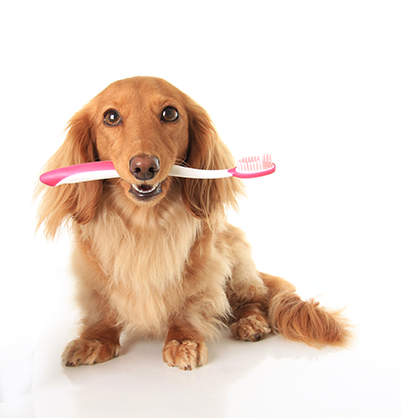
When teaching young children to brush their teeth, there are lots of strategies to help them develop good dental habits. Rhymes, songs, appealing toothpaste, and fun toothbrushes with their favorite television or movie character are ways we can make the process smooth and fun!
But what about our pets?
Dental hygiene is just as important for our furry friends as it is for us! Because most pets show early signs of dental disease by age three, it is important to get into the habit of brushing your pet’s teeth early in her life and to take your pet to see her veterinarian for regular wellness examinations. Early detection and treatment of periodontal disease (inflammation/infection of the supporting structures of the teeth) is important because in addition to bad breath, pain, and tooth and bone loss, periodontal disease can lead to kidney, liver, and heart problems.
If your pet’s breath makes you turn up your nose, she may already have dental disease. Bad breath – or halitosis – is caused by bacteria in the mouth. As bacteria multiply, they form plaque which hardens and forms tartar (also called calculus) within just a few days. Tartar continues to build up, eventually causing the gums to pull away from the teeth creating small pockets where bacteria can flourish.
Brushing your pet’s teeth may seem overwhelming – you’re not alone – many pet owners find it to be a daunting task and avoid it altogether. But by following these tips you, and your pet, may find it easier!
1) Start early! Start brushing your pet’s teeth as soon as you bring her home. It’s easier to train a puppy or kitten.
2) Start slowly. Don’t suddenly force a toothbrush into your pet’s mouth. Introduce the toothbrush slowly and allow your pet to get used to you lifting her lips to expose her teeth for short periods of time.
3) Pet Toothbrush. Use a toothbrush especially designed for cats or dogs. Puppies and kittens have smaller mouths so try using a finger brush or even a piece of gauze wrapped around your finger before graduating to a toothbrush. Ask your veterinary healthcare team for advice if you’re not sure which option would be best for your pet.
4) Pet Toothpaste. Never use human toothpaste or baking soda to brush your pet’s teeth. Human toothpaste contains harsh ingredients that aren’t meant to be swallowed. Some may contain xylitol – a sugar alcohol that is safe for people but is extremely toxic to dogs. Not only does baking soda taste bad, hindering your attempts to brush your pet’s teeth, it can upset the acid balance in your pet’s digestive system.
5) Timing. Choose an appropriate time to brush your pet’s teeth. For dogs, a good time is after some exercise so he’s more likely to sit still. Don’t initiate a game with your cat and then expect her to sit still. Be sure she’s calm before beginning.
6) Location. Be sure to pick a comfortable spot with good lighting. You need see your pet’s pearly whites and you both need to be comfortable.
7) Free samples! Give your pet a small sample of the toothpaste to give her a preview of the taste.
8) Technique. Lift your pet’s lip to expose her teeth and gums. Gently brush the outside of her teeth and gums. Focus on the outside surfaces – most pets won’t allow you to brush the inside surfaces of the teeth.
9) Stop! If your pet is getting agitated, stop! Even if you’ve only brushed a few teeth, it’s best to stop and try again tomorrow avoiding a negative association with teeth brushing.
10) Reward and praise! Be sure to give your pet lots of praise the whole time and reward her at the end with a treat or play session.
With February marking Pet Dental Month, now is a good time to speak to your veterinarian about your pet’s dental health! If you need help with your teeth brushing technique, ask your veterinary healthcare team. They can also advise if your pet needs a veterinary dental cleaning!